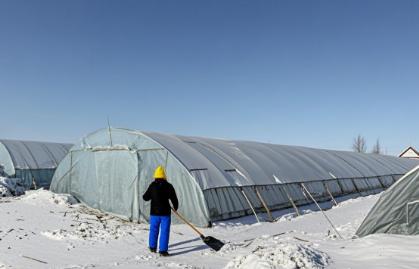When it comes to building a greenhouse in a cold climate, choosing the right materials is crucial. The best greenhouse materials for cold climates are those that can withstand harsh weather conditions, retain heat, and provide insulation. Here are some top options to consider:
1. Polycarbonate Panels
Polycarbonate panels are a popular choice for cold climate greenhouses. They are strong, durable, and provide excellent insulation. These panels allow sunlight to pass through while blocking harmful UV rays. Polycarbonate is also lightweight and easy to install, making it a practical choice for many gardeners. For example, the Premium Polycarbonate Greenhouse with Sliding Doors and Vents features heavy-duty black powder-coated aluminum frames and 6mm PC panels, which offer added protection and insulation.
2. Double-Pane Glass
Double-pane glass is another excellent option, although it is more expensive than polycarbonate. This material is more durable and provides better insulation. It's also more aesthetically pleasing than other materials. Double-pane glass can help maintain a stable temperature inside the greenhouse, even during the coldest months. The Janco Greenhouses Palmetto' – 8' X 10' Aluminum & Glass Greenhouse Kit is a good example, featuring 1/8" clear tempered safety glass and heavy gauge extruded aluminum construction that can withstand harsh weather conditions.

3. Plastic Film
For those on a budget, plastic film is a cost-effective and flexible option. Heavy-duty polyethylene film, such as the Plastic Sheeting (10 x 25, 6 Mil) – UV Protection Polyethylene Film, is tear-resistant and provides effective UV protection. This material is easy to install and can be customized to fit various greenhouse shapes. While plastic film may not be as durable as polycarbonate or glass, it can still provide good insulation when used in multiple layers with an air gap in between.
4. Bubble Wrap
Bubble wrap is an affordable and effective insulation material. It creates insulating air pockets that trap heat effectively. You can easily attach it to the interior walls and roof of your greenhouse. Users often report significant temperature reductions, enhancing comfort in greenhouses. This simple yet effective solution is perfect for added warmth during the coldest months.
5. Straw Bales
Straw bales are a natural insulator and are highly effective in trapping heat. You can place straw bales around the exterior of your greenhouse to provide additional insulation. This method is not only cost-effective but also eco-friendly.
6. Insulated Curtains or Blankets
Insulated curtains or blankets can be used to cover the greenhouse at night to trap heat. These materials are particularly useful in reducing heat loss during the coldest hours.
7. Concrete Floor
A concrete floor provides excellent insulation and helps regulate temperature. It can absorb and retain heat during the day and release it slowly at night, maintaining a stable environment for your plants.

Conclusion
When choosing the best greenhouse material for cold climates, consider your specific needs, budget, and the conditions in your area. Polycarbonate panels and double-pane glass offer excellent insulation and durability, while plastic film and bubble wrap provide cost-effective alternatives. Adding straw bales, insulated curtains, or a concrete floor can further enhance the energy efficiency of your greenhouse. With the right materials and design, you can create a thriving winter garden that withstands even the harshest conditions.
Welcome to have a further discussion with us.
Phone: +86 15308222514
Email: Rita@cfgreenhouse.com
Post time: Jul-10-2025







 Click to Chat
Click to Chat